Julian Costley, CEO & publisher at Bite-Sized Books, interviews some of our authors to provide further background to their books and to their approach to writing. And a little ‘behind-the-scenes’ glimpse of their life and influences!
In this, the second of our series; Meet Our Authors, Julian Costley, publisher at Bite-Sized Books, talks to Atima about her early years in India, being a film editor, her screenwriting successes, and her love of writing (and cooking).
We hear about her disciplined approach to plot creation, and her methodology to get manuscripts finished, all topped off with advice to the next generation of writers!
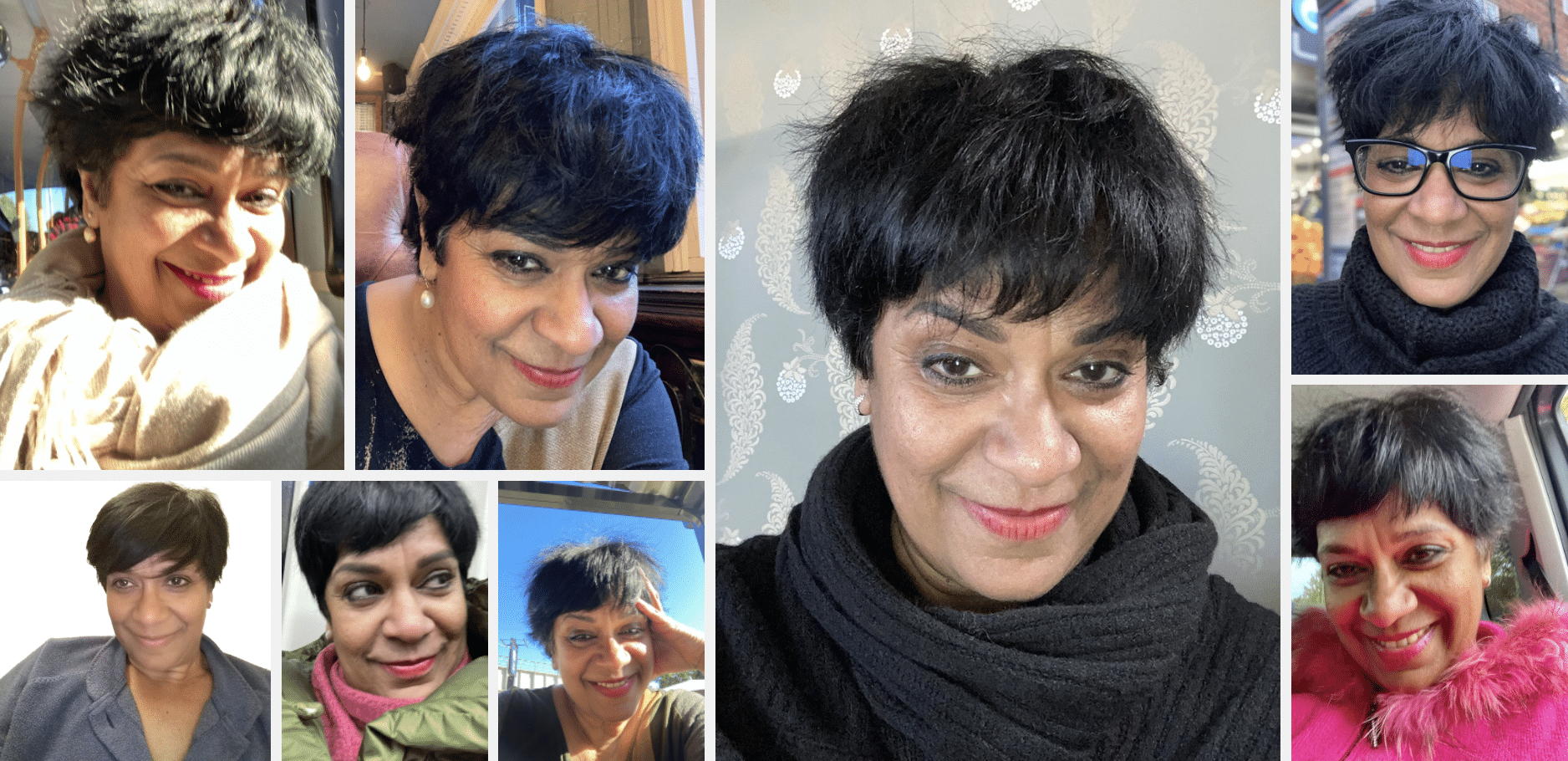
JC: I know you come from a family of acclaimed Hindi poets in India, so it seems like writing was the family business. Did you always want to be a writer?
AS: No! I had absolutely no interest in it. My parents only had writer and poet friends in India, and they would come to London and as far as I was concerned bore on about ‘Literature’—that’s all they ever talked about. And none of them had much money. They were always being thrifty, so no, being a writer wasn’t anything I aspired to. But as the song goes, ‘True love will find you in the end. You’ll find out who was your friend.’
I didn’t choose to be a writer but writing had plans for me.
JC: So, what did you do at university and beyond?
AS: I was a big reader, so it had to be Literature, but when I left university, I had no interest in being a writer or a teacher. By chance I saw an advert from a film company who were making films about the British Labour movement so off I trotted and presented myself as the perfect candidate. They liked my chutzpah but laughed at my nerve; I was putting myself forward for the job of PA when I didn’t even know what a PA was! Nor did I know what working ‘in the industry’ entailed.
They were very kind and took me on as an editing trainee and told me I’d have to learn on the job and make coffee and do the post. I had no problem with that, it was great fun. I earned my union card and started working in the industry as a documentary film editor, freelance as everyone was. I did this for 16 years (1985 – 1999) and worked on a number of shows for the BBC, and Channel 4. Working in cutting rooms around Soho ended up informing my first novel Transmission that came out in 1992.
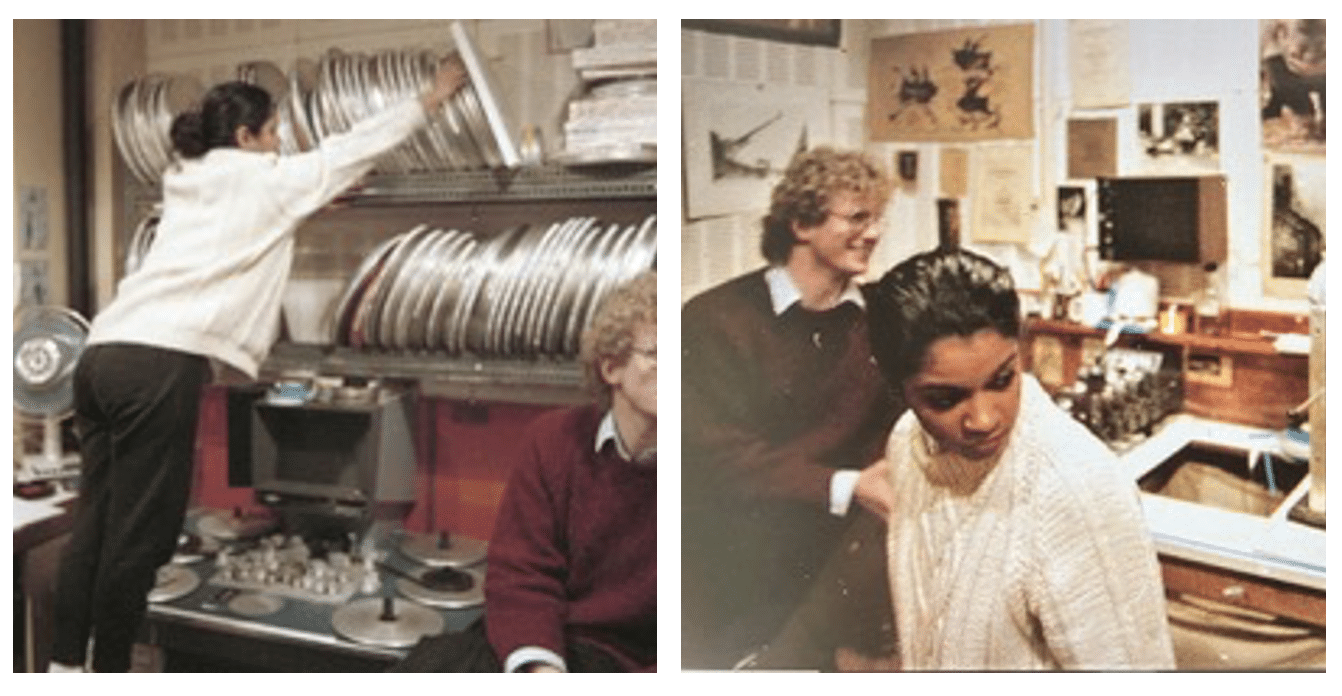
Atima working as an assistant film editor 1987
JC: So, you were editing during the day, writing at night?
AS: It all started, like everything else in my life, as a happy accident. While I was a trainee I had a hectic social life nightclubbing (my best friend was a DJ) but I had no entertainment in my flat—no TV or radio and there was nothing like the internet, this was 1989, so…in long hand I wrote a story based on a girl I had met at university, a wonderful person full of potential who had come from a house where they didn’t have a single book, but somehow she took a wrong turn and ended up becoming a heroin addict. I hadn’t seen her in years, and I thought maybe she had wound up dead in some crack den.
So, this story emerged as a kind of resurrection of that friendship. For some reason I sent it off to the Bridport Arts short story competition and to my surprise, out of 3000 entries I won first prize! £1000! I bought a computer with my winnings! The judge told me I must write a novel and he sent that short story Dragons in E8 (which refers to ‘chasing the dragon’ in the post code of Hackney) to his distinguished literary agent. They took me on and a year later I had written my first novel Transmission, which was then published by Serpents Tail.
JC: Your colleagues in television must have been impressed!
AS: No, I played it down in case they thought it meant I wasn’t a dedicated editor. I wanted to prove myself a good technician. The writing was for fun, while my career was film editing.
JC: So, what happened next?
AS: Transmission and then my second novel Looking for Maya, got put on to a lot of university courses around the world as ‘set texts’ novels that were about modern Britain. The British Council started inviting me to these universities to do public readings, teach creative writing and give lectures on ‘What is Multiculturalism?’ I was like a duck floating placidly but paddling like mad—I had no idea how to do all this, but I was determined to do a good job, and I went at it. I think I did ok, because I kept getting invited to more places.
Freelancing as a film editor meant I was able to fit in lots of Writers’ Visits and Writers’ Residencies to over 50 International cities over a period of 5 years. Go on a paid holiday, see the world, talk about my work, and meet people who read books. Yes please, this was the life I wanted!
I made lots of friends and got better at reading and teaching and lecturing, and meanwhile I was getting lots of work as an editor, so I began living a writer’s life as well as advancing my career in telly…and by night helping my BFF a club DJ, carrying boxes of records to the seediest dives in Soho, where he had gigs. We would emerge at 4am and go for breakfast. And then to work some hours later! Did I sleep, I don’t remember!
JC: So, by 2000 you had written 2 novels and had some experience of talking about them and teaching creative writing. Then things changed?
AS: Working in television became no longer fun. Now due to cuts, we had two weeks to make a 30min documentary instead of the luxurious 6 weeks we used to have. Instead of working with ideas, sequences, the juxtaposition of images… now it seemed I was working in a sausage making factory, churning content out. I didn’t want to do it. It was risky, but I had just published my second novel Looking for Maya (Quartet Books 1999) and to the horror of my parents, I chucked it in and thought I’ll try to be a writer! I missed the telly money I must say! I did get commissioned to write a play for the National Theatre, a couple of screenplays for TV, a libretto, and a few commissioned short stories but writing as a career was not financially viable. I had no wish to be an artist starving in the garret, but what else could I do for regular income?
JC: So that’s when teaching came into your life? Even though you said you’d never do it!
AS: Yes, I was approached by a director of a Study Abroad Program for American undergraduates in London to teach the subject of Immigration in London. She had read my book Transmission which had a Jewish, Asian and Caribbean trio as friends, and she was sure I had a lot to offer. I had no background in Sociology, but she helped me to write a syllabus and bingo, I’d embarked on another career, also freelance. And just as I’d done in telly, I moved around and worked for different universities. I did that for 16 years too.
I was a popular lecturer, and I created a lot of interesting syllabi about immigration, literature, film, travel writing but I felt I wasn’t a teacher by vocation. I didn’t think it was something that was ‘me’. What was me? I didn’t really know. Talk about a mid-life crisis in your 40’s!! I kept coming back to this idea of the authentic self, which I want to talk about.
For a long time after my first and second novels I thought as an Asian woman I ‘should’ be writing something that said Big Things about Race and Identity. I had nothing interesting to say on the subject and so I felt I’d failed as a writer. I realised later I had to learn to write what came naturally, and to discover effortlessly the kind of writer I was. At that point, I did not know so I stopped writing and continued teaching to earn a living.
JC: How did writing find you again?
AS: It was a long interval of no publication. 23 years! Time flies. My father died and I moved in with my mum back in the early 2000’s. I was now living life backwards, back in my childhood home in the old neighbourhood. I had ‘returned to the scene of the crime’ which is how I phrased it to all my friends. An adult woman moving in with mum has all kinds of unfashionable cadences! I had mixed feelings about it although I was sure of my decision because I knew my mum needed me. My parents had had a wonderful relationship, and she was lost without her best friend.
All the Indian aunties came around and praised me to the skies for being a good dutiful daughter—which did not thrill me, it made me think I was some sad spinster living in the 19th century! But what did engage me was the way those ladies and gentlemen in those closed Indian communities had remained unchanged from my teenage years. The aspirations, the gossiping, the preoccupations, the hypocrisies, the food, the generosity, the jokes. I started to observe them with a clinical eye. I felt grounded and useful being there for mum, but naturally I also felt trapped!
It’s marvellous how the imagination works, because this was the very situation that gave rise to a new direction in my writing. I’d go for long walks and observe people in my neighbourhood, some of whom I’d known as a kid, and I suddenly saw stories jumping out everywhere! I started wondering idly “What if one of them got bumped off, what would happen? How would they cover it up, and what would it mean to the community?” This idea tickled me, it felt transgressive, and I started building on it and it became my first novel with Bite-Sized Books called It Takes a Girl.
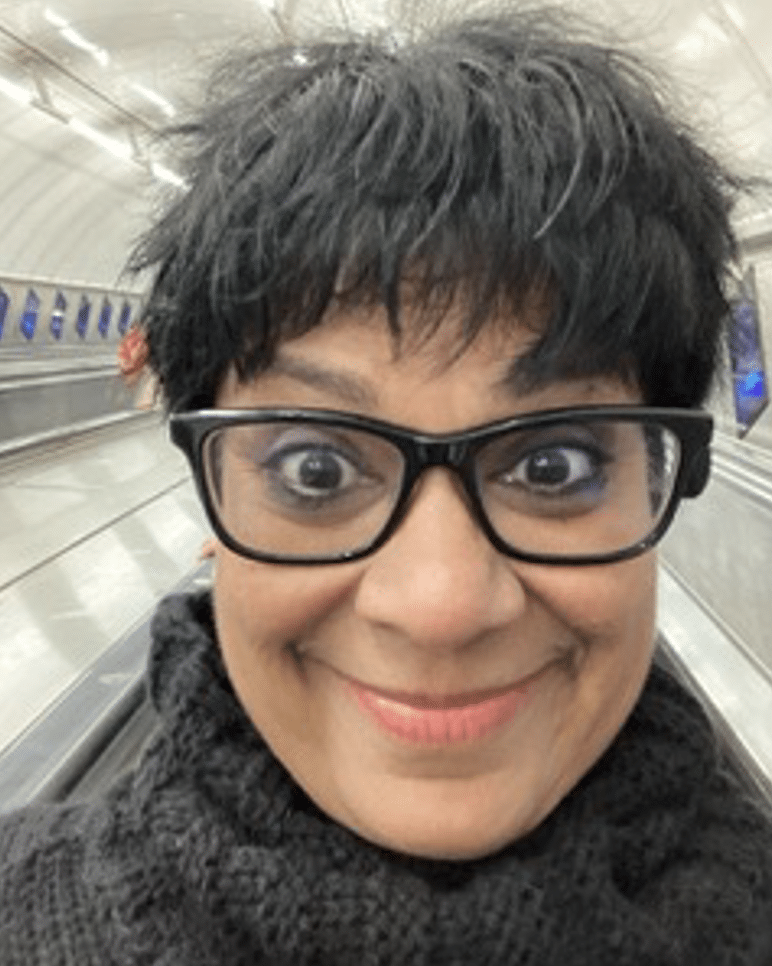
Atima when she heard It Takes a Girl had been accepted by Bite-Sized Books
JC: You started to write thrillers!
AS: Yes, it was automatic. I’ve always loved thrillers, from the Famous Five by Enid Blyton to the cosy Agatha Christie crime novels, to the more complex psychological works of Patricia Highsmith and the stylish world of small time crooks by Elmore Leonard. I’ve also always been a big fan of Dostoyevsky, Chekov, Dickens and Flaubert, as well as True Crime Netflix documentaries. The way It Takes a Girl started to come together in first draft, fast and furious and with me laughing out loud as I typed away, made me know I was getting close to my authentic self, not encumbered by what I was supposed to be or do.
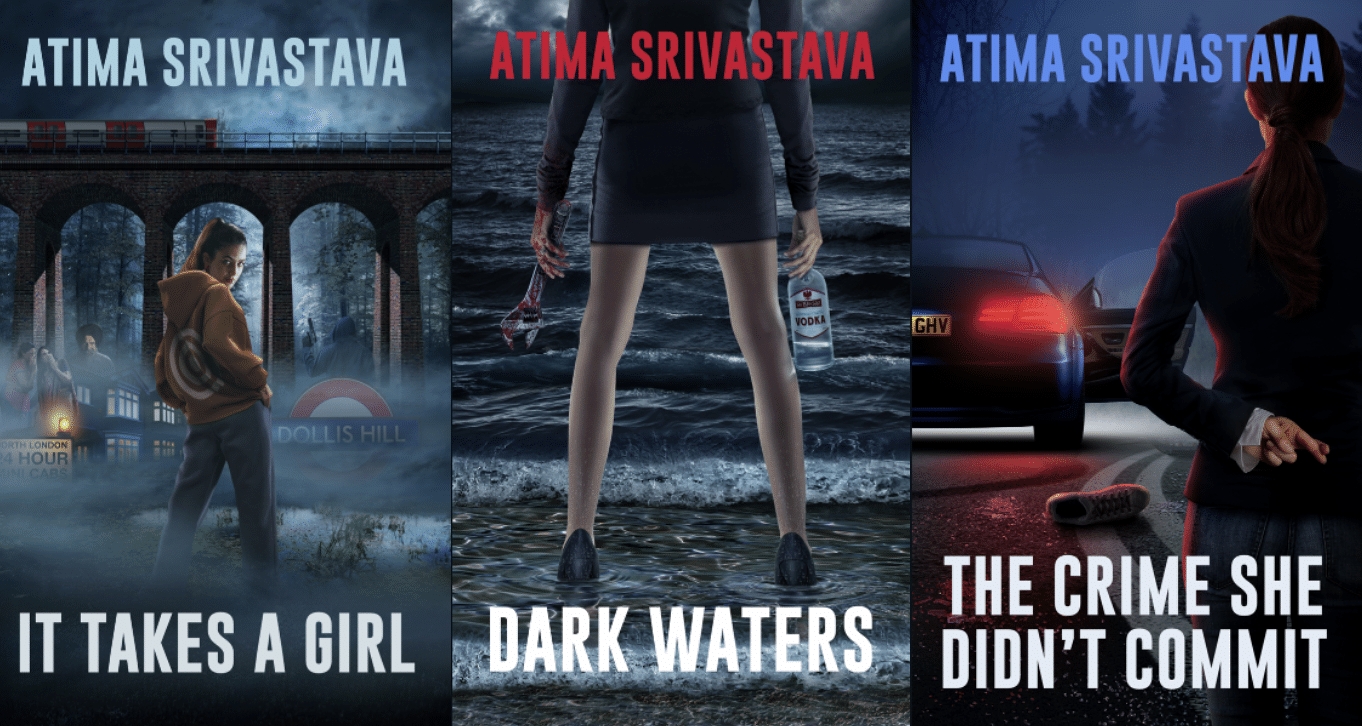
The Crime She Didn’t Commit – publishing late April 2024
JC: What are your views on marketing and publicity?
AS: I was told if it’s a 19year old protagonist then it’s a book for a YA (Young Adult) audience, so you’d better take out the swearing and references to porn in it, read a lot of that genre and then make sure your book conforms to its rules. Make sure to follow YA novelists on Instagram and ‘like’ what they like. Oh brother! I thought that was a dreary way to live! Sausage making factory! Why couldn’t I be allowed to just write a quirky thriller with a heroine who happened to be from a particular community and in this case, of a particular age?
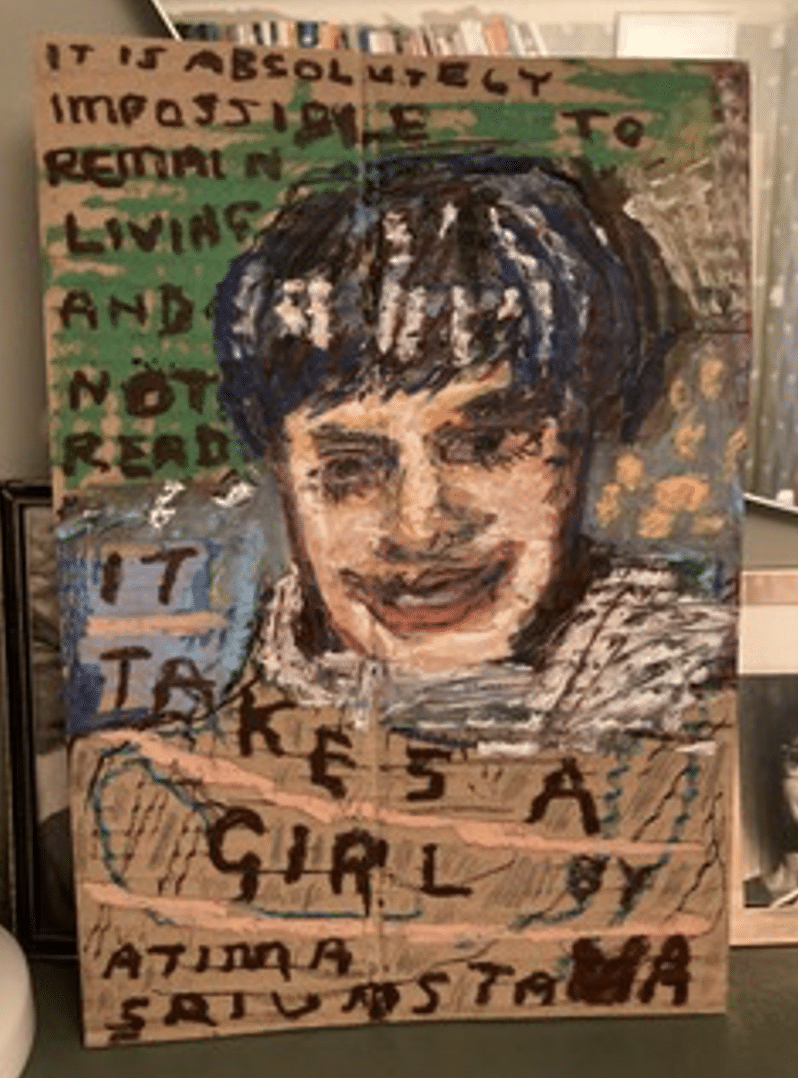
Unconventional publicity. Drawing by artist and Art critic Matthew Collings
After all, and forgive me for the lofty comparison, Catcher in the Rye and To Kill a Mockingbird are not “YA” books, even though they have young protagonists. Why had the world changed so much? When I wrote my first two novels in the 90’s no one had tried to pigeonhole me, in fact they said let’s call them London novels rather than Asian novels and I had been very glad of where they put my books in the bookshops.
So, in this my ‘renaissance’ as a writer I didn’t bother with any pieces of ‘advice’ and I was so lucky to meet Bite-Sized Books because they didn’t care about stuffing me into a genre, they said they just liked the books (I wrote another thriller called Dark Waters) and wanted to publish them. Hooray! The sentence every writer wants to hear from a publisher. It galvanised me as a writer.
JC: Can you tell us a little about your process?
AS: Yes. I’ve just finished my fifth novel (the third for Bite-Sized Books), another thriller, called The Crime She Didn’t Commit. Let me tell you how I wrote it. I got quite a lot of ‘likes’ for this post on Facebook.
I have unbelievably got to THE END of Draft 1.
320 pages*, 28 chapters. Deliriously happy. Every morning in February and March, I’d wake up thinking I’ve got to get the story from A to B, from this movement to the next, from card 1 to card 2 to card 3 etc – Each card/chapter had the basic movement, i.e. (and this is not it, this is just an example)
1. X leaves the house and trips over a body that they think their brother killed
2. X disposes of the body/how and why and when
3. Someone sees X, how? What were they doing, what will they do?
4. X covers tracks etc etc
They are really bald, bold plot points, and each card must be expanded to around 8 pages.
And I always think, but how do I do it, I don’t know, I just don’t know. I wail this to myself as I make my coffee. I give myself some get outs: MUST clean the kitchen instead/Go out and buy clothes/Go to the movies…
But can’t. Just can’t shift from the seat until 1pm at least.
It’s really weird, deliciously compulsive behaviour. Can’t stop till I’ve got it right, and then on to the next.
So, I’d sit down at the usual time, 7.30am and stop at 1pm for lunch and I’d done it. I’d do some corrections in the afternoon if it didn’t feel quite right, but generally, it just kept moving. All by itself it seemed. I’m so shocked and happy about it! A chapter a day, usually. Word count and page count, achieved.
In flow, baby. In flow!
A friend came over last night and poor guy, I just started telling him blow by blow the story of The Crime She Didn’t Commit…and I was amazed I could remember the entire plot, chapter by chapter and it all worked. By that I mean, all the pieces fit! The main point of the exercise was to see if I could hold the entire story of twists and turns in my head and retell it. When you do that, you can easily tell if there are bits that is just you showing off, or trying to be clever or ‘padding’.
When you ‘speak’ the story you move fast and forward, just like a film does. This happens, then this happens, then that happens because this happened. You may have a few ‘longueurs’ when you’re writing it of course: the descriptions, the inner monologues, the banter dialogue, the comedy bits, showing a side to the character that is at odds with what we think they are…but all that has to take second place to the plot which like an express train must speed to its destination and keep the reader turning the pages.
For this type of book, anyway. That’s the goal. And I think the final cut should be no more than 275 pages, and each chapter should be full of unexpected liveliness pushing, moving the story forward, twisting and turning as it goes…Well, hopefully.
JC: Wonderful! Interesting! Do you have any hobbies, Atima?
AS: I’ve never had hobbies. In my free time I cook, watch movies and go to the theatre. I’d rather devote my time to writing now. I’m 62 and I know I have a lot of books I want to write and the fun of it is indescribable! There’s nothing more life enhancing than entering a world of your imagination.
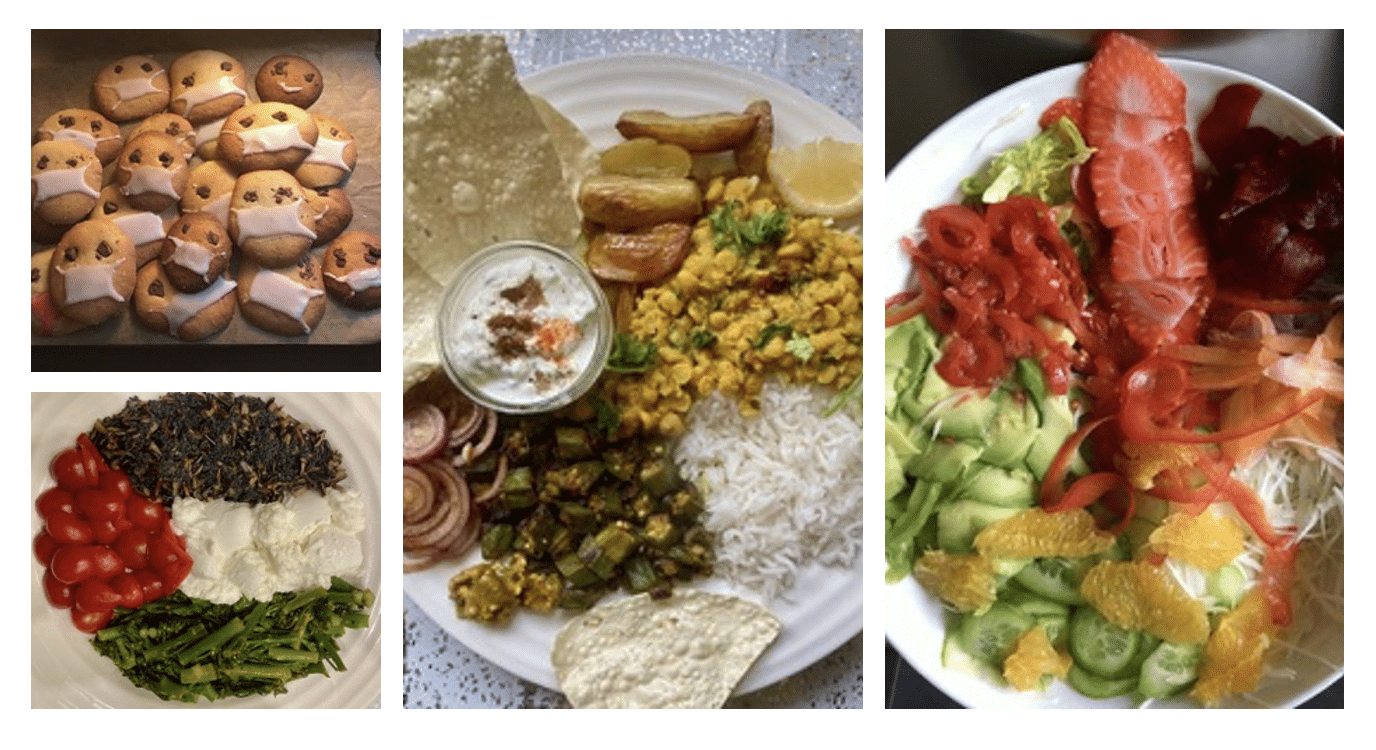
Atima’s culinary preparations
JC: Any advice for aspiring writers?
AS: If you can do something else, do it. No one has a gun to your head, no one cares if you do it, no one offers you good money for it, and yet you can’t help doing it. It’s the most exciting thing to do. Writing everyday matters. Luck matters. Being your authentic self matters. Not giving up matters the most. True love does find you in the end…but you have to put the work in.
JC: Always a pleasure to talk to you Atima. We look forward to publishing more of The Killer Women Series!
